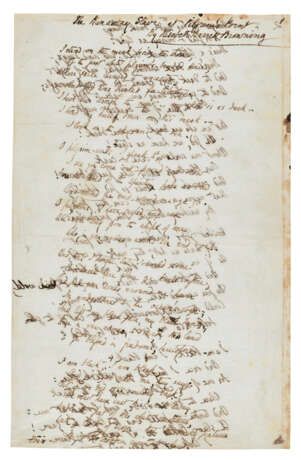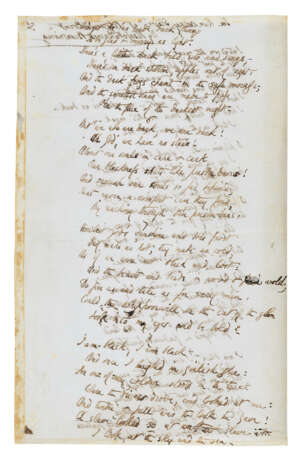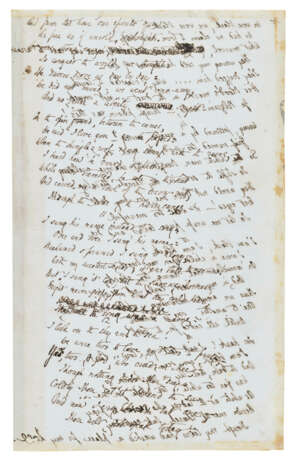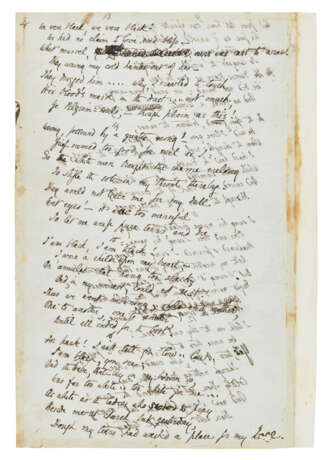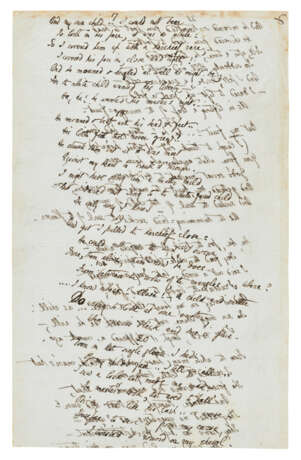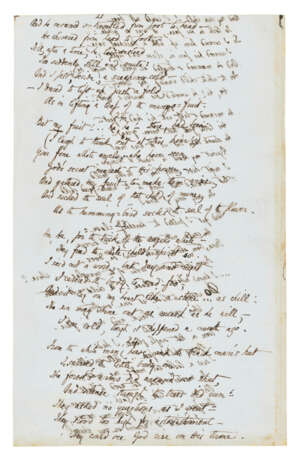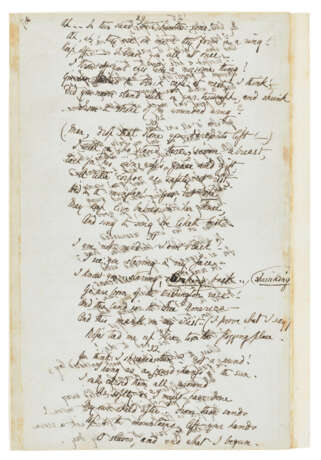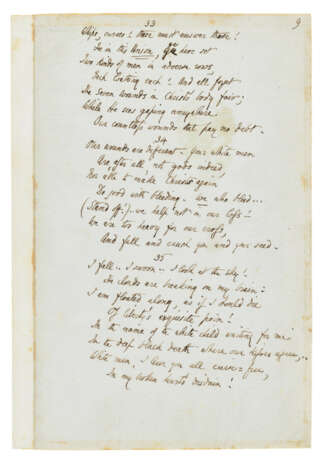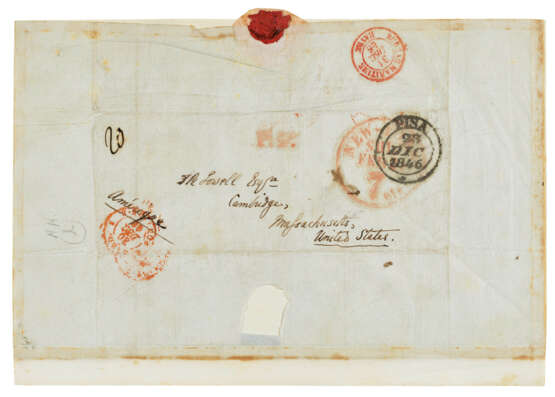ID 1108873
Lot 74 | Elizabeth Barrett Browning (1806-1861)
Estimate value
£ 40 000 – 60 000
Autograph poetry manuscript signed, ‘The Runaway Slave at Pilgrim’s Point’, [Pisa], [December 1846]
Nine pages, 210 x 135mm, on three bifolia, the final bifolium drafted on the first page only and with an integral address leaf, titled and signed (‘Elizabeth Barrett Browning’) in autograph at the head of the poem, paginated by the author, complete as first published in 35 stanzas, 245 lines in total, with autograph cancellations and emendations scattered throughout. Brown morocco-backed slipcase, cloth folder.
Provenance:
(1) James Russell Lowell (1819-1891, American Romantic poet); addressed in autograph to ‘JR Lowell, Cambridge, Massachusetts, United States’, postmarked Pisa, 23 December 1846, with further postmarks from Gard, Le Havre and New York.
(2) Arthur A. Houghton, Jnr (1906-1990); his sale, Christie's, 13 June 1979, lot 67.
Elizabeth Barrett Browning’s final draft of ‘The Runaway Slave at Pilgrim’s Point’, her anti-slavery polemic, sent to the poet James Russell Lowell for inclusion in the abolitionist compilation, The Liberty Bell. Written in Pisa during the autumn of 1846, Barrett Browning was proud of the ‘ferocious’ theme of her passionate, occasionally melodramatic poem: an enslaved woman, of African descent, describes how she was separated from the man she loved, whipped, raped by her master and driven to kill her newborn child – ‘too white, too white for me!’.
Elizabeth Barrett Browning wrote to her former tutor Hugh Boyd on 21 December 1846: ‘I am just sending off an anti-slavery poem for America, too ferocious, perhaps for the Americans to publish: but they asked for a poem and shall have it’. She was referring to ‘The Runaway Slave at Pilgrim Point’, which first appeared in print in 1848 as part of a collection of anti-slavery writings published for sale at the annual Boston Anti-Slavery Bazaar. The collection was entitled The Liberty Bell, issued by Friends of Freedom. The present manuscript, posted only two days after her letter to Boyd and differing in only a few minor details of punctuation from the text published in The Liberty Bell, must be the same one posted to America, from which the first printing was taken. Her fear that the poem might be too ferocious to publish seems to have been at least partially founded, accounting for the two-year delay before it appeared in print.
James Russell Lowell was instrumental in securing EBB’s contribution to The Liberty Bell – he and his wife, Maria White, were prominent members of the American abolitionist movement, both actively involved in the Boston Bazaar, and he himself contributed a poem to the same 1848 edition – but slavery was an issue that affected EBB strongly. In a letter written from Florence in 1853 to her friend Anna Jameson she declared: ‘you think a woman has no business with … the question of slavery? Then she had better use a pen no more!’. ‘I belong to a family of West Indian slaveholders, and if I believed in curses, I should be afraid’, she wrote to John Ruskin in 1855; that her father continued to own slaves until the passage of the Slavery Abolition Act has been posited as one of the reasons behind their enduring rift. ‘The Runaway Slave’ was one of two poems she wrote highlighting the barbarity of the institution and her support for abolition: in a ‘A Curse for a Nation’, published in the 1856 edition of The Liberty Bell, she took up the cause in print once more. EBB's anti-slavery poems led Frederick Douglass to pause by her grave in Florence in tribute during his travels in Italy.
The poet rarely identified or signed herself ‘Elizabeth Barrett Browning’; she maintained the characteristic use of her signature ‘EBB’ initials after her marriage to Robert Browning. That she does so here, setting the manuscript out more formally, presumably reflects its destiny for publication.
| Place of origin: | England, Italy, USA |
|---|---|
| Auction house category: | Letters, documents and manuscripts |
| Place of origin: | England, Italy, USA |
|---|---|
| Auction house category: | Letters, documents and manuscripts |
| Address of auction |
CHRISTIE'S 8 King Street, St. James's SW1Y 6QT London United Kingdom | |||||
|---|---|---|---|---|---|---|
| Preview |
| |||||
| Phone | +44 (0)20 7839 9060 | |||||
| Buyer Premium | see on Website | |||||
| Conditions of purchase | Conditions of purchase |
